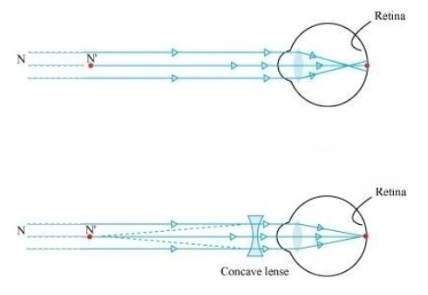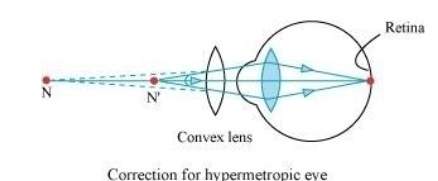NCERT Solutions for Class 10 Science Chapter 10: Both intext and exercise questions given in the NCERT Books are of great importance for students. It is essential that students are aware of the accurate answers to the questions. This article gives detailed answers for NCERT Class 10 Science Chapter 10 The Human Eye and the Colourful World.
Questions given in the NCERT books are always considered very important as not only do they help you to analyse your understanding of the concepts involved in a chapter but also in preparing for the examinations. Students should read the chapters carefully along with attempting the questions given.
Also Check: Difference Between Pound and Kilogram: Major Differences Between The Units
In this article students can find the NCERT Solutions for Class 10 Science Chapter 10. Students can download the NCERT Solutions for Class 10 The Human Eye and the Colourful World in an easy pdf format.
NCERT Class 10 Science The Human Eye and the Colourful World Solutions
Check below questions and answers of NCERT Class 10 Chapter 10 The Human Eye and the Colourful World. Students can go through the solutions for both exercise and intext questions.
Intext Questions and Solutions Page no. 164
Q. What is meant by power of accommodation of the eye?
Sol. Power of the accommodation of the eye is the ability of an eye to adjust itself in different conditions. For example-When the ciliary muscles are relaxed, the eye lens becomes thin, leading to an increase in focal length. Due to this, distant objects are clearly visible to the eyes.
In case of nearby objects, the ciliary muscles contract making the eye lens thicker. Hence, the focal length of the eye lens decreases and nearby objects become visible to the eyes. Hence, the human eye lens is able to adjust its focal length to view both distant and nearby objects on the retina.
Q. A person with a myopic eye cannot see objects beyond 1.2 m distinctly. What should be the type of the corrective lens used to restore proper vision?
Sol. The person is able to see nearby objects clearly, but he is unable to see objects beyond 1.2 m. This happens because the image of an object beyond 1.2 m is formed in front of the retina and not at the retina.
To correct this defect of vision, use of a concave lens is required. The concave lens will bring the image back to the retina.

Q. What is the far point and near point of the human eye with normal vision?
Sol. The far point of the normal human eye is infinity. The far point of the eye is the maximum distance to which the eye can see the objects clearly.
The near point of the eye is the minimum distance of the object from the eye, which can be seen distinctly without strain. For a normal human eye, this distance is 25 cm.
Q. A student has difficulty reading the blackboard while sitting in the last row. What could be the defect the child is suffering from? How can it be corrected?
Sol. He is unable to see distant objects clearly. He is suffering from myopia. This defect can be corrected by using a concave lens.
Also Check: Human Eye: Structure And Functioning
NCERT Class 10 Science Chapter 10 Exercise Questions
Q. The human eye can focus on objects at different distances by adjusting the focal length of the eye lens. This is due to
(a) presbyopia. (b) accommodation. (c) near-sightedness. (d) far-sightedness.
Sol. (b) Accommodation
Q. The human eye forms the image of an object at its
(a) cornea. (b) iris. (c) pupil. (d) retina
Sol. (d) Retina
Q. The least distance of distinct vision for a young adult with normal vision is about
(a) 25 m. (b) 2.5 cm. (c) 25 cm. (d) 2.5 m
Sol. (c) 25 cm
Q.The change in focal length of an eye lens is caused by the action of the
(a) pupil. (b) retina. (c) ciliary muscles. (d) iris
Sol. (c ) ciliary muscles
Q. A person needs a lens of power –5.5 dioptres for correcting his distant vision. For correcting his near vision he needs a lens of power +1.5 dioptre.
What is the focal length of the lens required for correcting (i) distant vision, and (ii) near vision?
Sol. (i) Power of the lens used for correcting distant vision = −5.5 D
P=1/f
f=1/P=−1/5.5=−0.181m
The focal length of the lens for correcting distant vision is−0.181 m.
(ii) Power of the lens used for correcting near vision = +1.5
P=1/f
f=1/P=1/1-5=0.667m
The focal length of the lens for correcting near vision is 0.667 m.
Q. The far point of a myopic person is 80 cm in front of the eye. What is the nature and power of the lens required to correct the problem?
Sol. In this defect, the image is formed in front of the retina. Hence, a concave lens is used to correct this defect of vision.
Object distance, u= infinity
Image distance, v= −80 cm
Focal length =f
1/v−1/u=1/f
1/f=−1/80−1/∞
f=−80cm
f=−0.8m
Now,
P=1/f
P=1/−0.8=−1.25D
A concave lens of power −1.25 D is required by the person to correct his defect.
Q. Make a diagram to show how hypermetropia is corrected. The near point of a hypermetropic eye is 1 m. What is the power of the lens required to correct this defect? Assume that the near point of the normal eye is 25 cm.
Sol. A person suffering from hypermetropia can see distinct objects clearly but faces difficulty in seeing nearby objects clearly. It happens because the eye lens focuses the incoming divergent rays beyond the retina. This defect of vision is corrected by using a convex lens.
Now,
Object distance, u= −25 cm
Image distance, v= −1 m = −100 m
Using the lens formula,
1/v−1/u=1/f
1/f=−1/100+1/25
f=33.33cm
f=0.33m
Now,
P=1/f
P=1/0.33=3D
A convex lens of power +3.0 D is required to correct the defect.

Q. Why is a normal eye not able to see clearly the objects placed closer than 25 cm?
Sol. A normal eye is unable to clearly see objects placed closer than 25 cm because the ciliary muscles of eyes are unable to contract beyond a certain limit and the object appears blurred and produces strain in the eyes.
Also Check: Law Of Conservation Of Mass: Definition, Formula And More
Q. What happens to the image distance in the eye when we increase the distance of an object from the eye?
Sol. When we increase the distance of an object from the eye, the image distance in the eye does not change. The increase in the object distance is compensated by the change in the focal length of the eye lens. The focal length of the eyes changes in such a way that the image is always formed at the retina of the eye.
Q. Why do stars twinkle?
Sol. Stars are considered as point sources of light. They emit their own light. They twinkle due to the refraction of light by the atmosphere. When the light coming from stars enters the earth’s atmosphere, it gets refracted at different levels. When the star light refracted by the atmosphere comes more towards us, it appears brighter. Hence, it appears as if the stars are twinkling at night.
Q. Explain why the planets do not twinkle.
Sol. Planets appear larger in size than the stars as they are closer to earth. The different parts of planets produce either brighter or dimmer effects in such a way that the average of brighter and dimmer effect is zero. Hence, the twinkling effects of the planets are nullified and they do not twinkle.
Q. Why does the sky appear dark instead of blue to an astronaut?
Sol. The sky appears dark instead of blue to an astronaut because of the absence of atmosphere in outer space. Atmosphere can scatter the sunlight. As the sunlight is not scattered, no scattered light reaches the eyes of the astronauts and the sky appears black to them.
To download these solutions in pdf, refer to the below link:
| Download NCERT Class 10 Science Chapter 10 The Human Eye and the Colourful World Solutions PDF |
CBSE Video Courses for Class 10 Students
Class 10 students can study effectively for the exams with the help of video courses prepared by the subject matter experts. These video courses will explain the concepts in a simple and interactive manner which will help learners to understand clearly.
Also, check
Comments
All Comments (0)
Join the conversation